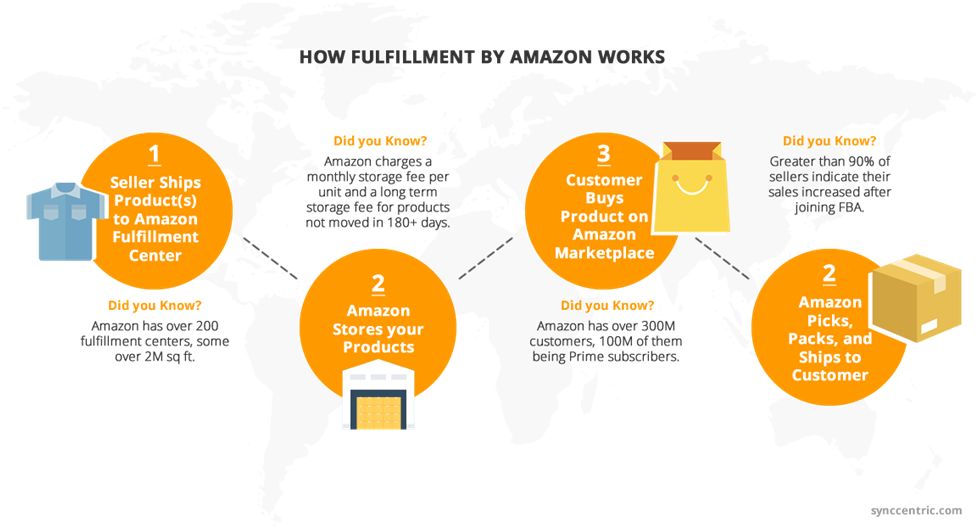
Selling on Amazon can leave you with a lot of questions and a lot to learn. It doesn’t matter if you’re brand new or you’ve been selling for quite some time now, there’s always something new to learn. Not every selling tip out there is right for every Amazon seller and choosing what’s best for you can be a little overwhelming when you aren’t sure where to start.
There are a lot of helpful tools and tips out there, so sometimes it’s about playing a small game of trial and error. You can minimize the error part by using tools others have already vetted and vouch for. This means it’s time to try out tools like Amazon fee calculators, Amazon sales rank calculators and seek tips from the very best sellers on the site.
An Amazon FBA fee calculator can help you focus on the of your item while taking into account Amazon FBA fees. Amazon sales rank calculators exist to help you figure out where your listings are falling in comparison to your direct competitors. Seeking out tips from the big guys is just a good tactic for overall learning. They’re the big guys for a reason.
Learning about how to use an Amazon FBA fee calculator or another Amazon seller fees calculator can be part of your plan to become the most successful Amazon seller you can possibly become. These aren’t the only tools or tips you can use however, so stick around. Here are seven tips you can use to help sell your products on Amazon.
Table of Contents
1. Use The Right Amazon Fee Calculator For You

Amazon fee calculators were already talked about in the intro here but this is a tip so important it’s worth repeating. The profits you make are directly affected by how much it costs you to list a product, what FBA fees are involved, and getting the price point exactly right. Don’t risk your success by making rough estimates and using guesswork.
FBA fee calculators can help make sure you aren’t pricing yourself out of the market, but ensure you’re also still making a profit. Both of those components are a very big part of your success, so using an effective tool is important. There are a lot of FBA calculators out there so finding the right one for you might take a few tries but it’s out there.
Don’t forget that FBA fees are going to change based on a variety of factors like the amount of storage your product will need, and how long it’s been kept in the Amazon warehouse. Determining these fees on your own just isn’t possible if you want to be completely accurate. Give yourself a break and find an Amazon fee calculator that works for you.
2. Your Titles And Descriptions Should Be SEO Friendly

If you aren’t sure how SEO (search engine optimization) works there are plenty of tips and tutorials online for you to use. Spend a little time learning about how to make SEO work for you as an Amazon seller. Your product listings and descriptions make a huge difference. They should be based on what a customer is going to search naturally to find what you’re selling.
This tip is helpful and important no matter which stage of the Amazon seller game you’re at. If you’ve been selling for a long time, you can use SEO tips to make your listings even more successful. If you’re brand new, you can start out with the best SEO practices in mind. Either way, this isn’t something you can ignore.
The more traffic your listings pull in the more chance you have to convert a looker to a paying customer. Focus on making your product listing titles accurate, easy to understand, and make sure your descriptions are clear as well. Honesty and clarity in your titles and descriptions coupled with the best SEO practices will make a dramatic difference in your sales figures.
3. Don’t Neglect Your Customer Reviews
Amazon’s review system is something their customers have come to rely on heavily when making decisions about purchases. If your product is reviewed and ranked well by customers that’s going to encourage more people to buy it. Because people trust verified Amazon reviews so much, you cannot afford to neglect this part of your Amazon business.
You can’t solicit or incentivize reviews on Amazon. They’re very clear about the rules on buying reviews or even demanding positive reviews from your past customers. That means you need to make sure your follow-ups are asking for reviews based on their experience with you and your product. Never directly request a five-star review.
Don’t wait for reviews to come in. Make sure you’re using the follow-up email tools sellers have at their disposal. People get busy and the reminder that they purchased something can spark them to come to your listing and leave their honest feedback. It can also give you a chance to make sure you’re doing what you can to head off any possible negative reviews.
If you make sure you’re checking in on customers shortly after their purchase, there’s a bigger chance they’ll work directly with you if something is wrong. Make sure you’re giving them the chance to know you care about their experience and want to know if something is wrong. Doing this could even prompt a potential negative review to turn into a positive review in the end.
4. Use A Review Tracking Tool
While reviews are still on your mind it’s worth mentioning this tip too. A lot of times a customer may leave a review under a different name than what you shipped their order to. This can make it difficult to reach out to someone who has left a review about a bad experience.
Review trackers can help you match up your negative reviews with the right order number so you have the correct contact information. This is a key part of managing the reviews you get and trying to get the highest review scores possible.
Negative reviews can be frustrating to read, so if you need a bit of time to calm down, take it. Then make sure you’re reaching out with a genuine focus of solving the customer’s problem. Be prepared with solutions like offering a replacement if the item isn’t working. Make sure you aren’t reacting out of anger and reaching out to the customer with demands that they change their review.
Amazon does allow customers to edit their reviews for up to 60 days are their purchase so don’t feel defeated right away. If you’re proactive and follow up with the customer offering workable solutions there’s a good chance you can turn things around. Again, remember you can’t demand a review change or specific score, but you can ask them to review their honest experience.
5. Use Professional Quality Product Images
Your product images shouldn’t ever make a customer second guess what type of seller they’re dealing with. They’re very important to how your potential customers will view you as a seller, and even what assumptions they will make about your item’s quality. Make sure your images are well lit and look great. This includes keeping the product highly visible if your background is colorful or busy.
Amazon has built a reputation of having high-quality products customers can purchase at great prices. Don’t risk losing sales because a customer sees your image and wants to move on to a listing that looks more on brand for Amazon. Focus on making sure your product images are as professional as they can possibly be.
6. Good Customer Service Really Matters
This is about more than just handling a negative review with a professional and helpful manner. Your customer’s experience starts the minute they click on your listing. Make sure you’re making it as awesome as possible from the first impression to their very last interaction with you. Answer any questions they ask on your listing quickly and accurately.
If there’s a question you don’t know the answer to, make sure you do research so you aren’t giving an answer that isn’t true. Keep your product listings and descriptions as useful as possible. If there’s something you can fill in while listing your item, make sure you do. Don’t skip a box on your listing page just to get your listing up faster.
Customer service will be just as important as every other tip you’ve read about so far. Don’t skimp on any part of your attempt to make customers as happy as they can be.
7. Use Your Competitors To Your Advantage
You can get a lot of valuable information from your competitors. Watch what they’re using for listing titles, descriptions, and price points. Use that information to make your own listings even better. If they’re getting more traffic, figure out what you can adjust based on what they’re doing.
Watch their reviews. Are their customers consistently upset about a specific problem with their product? See if you can add something to your line of listings that fixes their complaint about your competitor. Don’t underestimate the value of what you can learn from other sellers just because they’re a rival. Use their information to increase your own profits
Conclusion:
You’ll always be evolving as an Amazon seller. Tips like the ones you’ve seen here today can help you on your path to success. Keep trying things and find what works for you. If a tip isn’t making sense for your specific product, skip it and move on. Once you find what works, stick with it. Your customers will be happier, and your profits will be the proof you’re doing the right thing.
Ashley Coblentz is a lifestyle blogger
currently writing for Synccentric
and political journalist. After graduating from college, she worked as a
Registered Nurse at one of the largest hospitals in South Dakota until deciding
to be a full-time mom. She remains very passionate about the nursing profession
and often volunteers in her extra time to teach community education classes on
first aid and other related topics. She has one amazing child who keeps her on
her toes. Who knew 10-year-olds could have so many questions? If you want to
keep up with her and see what she’s writing next you can find her on Twitter or check out her portfolio for other fun reads.